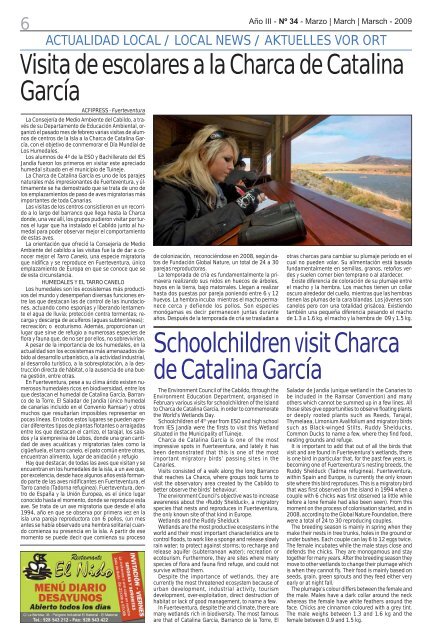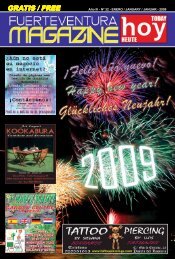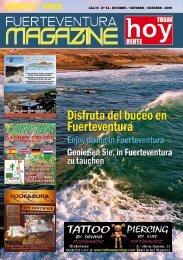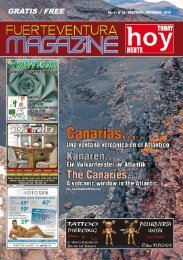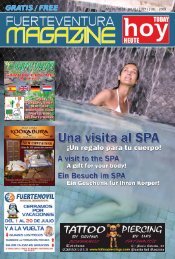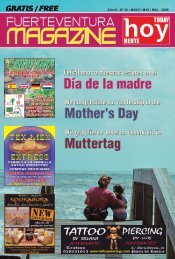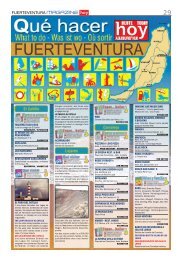actualidad local - fuerteventura magazine hoy
actualidad local - fuerteventura magazine hoy
actualidad local - fuerteventura magazine hoy
You also want an ePaper? Increase the reach of your titles
YUMPU automatically turns print PDFs into web optimized ePapers that Google loves.
6<br />
Año III - Nº 34 - Marzo | March | Marsch - 2009<br />
ACTUALIDAD LOCAL / LOCAL NEWS / AKTUELLES VOR ORT<br />
Visita de escolares a la Charca de Catalina<br />
García<br />
ACFIPRESS - Fuerteventura<br />
La Consejería de Medio Ambiente del Cabildo, a través<br />
de su Departamento de Educación Ambiental, organizó<br />
el pasado mes de febrero varias visitas de alumnos<br />
de centros de la Isla a la Charca de Catalina García,<br />
con el objetivo de conmemorar el Día Mundial de<br />
Los Humedales.<br />
Los alumnos de 4º de la ESO y Bachillerato del IES<br />
Jandía fueron los primeros en visitar este apreciado<br />
humedal situado en el municipio de Tuineje.<br />
La Charca de Catalina García es uno de los parajes<br />
naturales más impresionantes de Fuerteventura, y últimamente<br />
se ha demostrado que se trata de uno de<br />
los emplazamientos de paso de aves migratorias más<br />
importantes de toda Canarias.<br />
Las visitas de los centros consistieron en un recorrido<br />
a lo largo del barranco que llega hasta la Charca<br />
donde, una vez allí, los grupos pudieron visitar por turnos<br />
el lugar que ha instalado el Cabildo junto al humedal<br />
para poder observar mejor el comportamiento<br />
de estas aves.<br />
La orientación que ofreció la Consejería de Medio<br />
Ambiente del cabildo a las visitas fue la de dar a conocer<br />
mejor el Tarro Canelo, una especie migratoria<br />
que nidifica y se reproduce en Fuerteventura, único<br />
emplazamiento de Europa en que se conoce que se<br />
de esta circunstancia.<br />
HUMEDALES Y EL TARRO CANELO<br />
Los humedales son los ecosistemas más productivos<br />
del mundo y desempeñan diversas funciones entre<br />
las que destacan las de control de las inundaciones,<br />
actuando como esponjas y liberando lentamente<br />
el agua de lluvia; protección contra tormentas; recarga<br />
y descarga de acuíferos (aguas subterráneas);<br />
recreación; o ecoturismo. Además, proporcionan un<br />
lugar que sirve de refugio a numerosas especies de<br />
flora y fauna que, de no ser por ellos, no sobrevivirían.<br />
A pesar de la importancia de los humedales, en la<br />
<strong>actualidad</strong> son los ecosistemas más amenazados debido<br />
al desarrollo urbanístico, a la actividad industrial,<br />
al desarrollo turístico, a la sobrexplotación, a la destrucción<br />
directa de hábitat, o la ausencia de una buena<br />
gestión, entre otras.<br />
En Fuerteventura, pese a su clima árido existen numerosos<br />
humedales ricos en biodiversidad, entre los<br />
que destacan el humedal de Catalina García, Barranco<br />
de la Torre, El Saladar de Jandía (único humedal<br />
de canarias incluido en el Convenio Ramsar) y otros<br />
muchos que resultarían imposibles representar en<br />
pocas líneas. En todos estos lugares se pueden apreciar<br />
diferentes tipos de plantas flotantes o arraigadas<br />
entre los que destacan el carrizo, el tarajal, los salados<br />
y la siempreviva de Lobos, donde una gran cantidad<br />
de aves acuáticas y migratorias tales como la<br />
cigüeñuela, el tarro canelo, el pato común entre otras,<br />
encuentran alimento, lugar de anidación y refugio<br />
Hay que destacar, de todas las aves que visitan y se<br />
encuentran en los humedales de la isla, a un ave que,<br />
por excelencia, desde hace algunos años está formando<br />
parte de las aves nidificantes en Fuerteventura, el<br />
Tarro canelo (Tadorna refuginea). Fuerteventura, dentro<br />
de España y la Unión Europea, es el único lugar<br />
conocido hasta el momento, donde se reproduce esta<br />
ave. Se trata de un ave migratoria que desde el año<br />
1994, año en que se observa por primera vez en la<br />
isla una pareja reproductora con 6 pollos, (un mes<br />
antes se había observado una hembra solitaria) cuando<br />
comienza su presencia en la isla. A partir de ese<br />
momento se puede decir que comienza su proceso<br />
de colonización, reconociéndose en 2008, según datos<br />
de Fundación Global Nature, un total de 24 a 30<br />
parejas reproductoras.<br />
La temporada de cría es fundamentalmente la primavera<br />
realizando sus nidos en huecos de árboles,<br />
<strong>hoy</strong>os en la tierra, bajo matorrales. Llegan a realizar<br />
hasta dos puestas por pareja poniendo entre 6 y 12<br />
huevos. La hembra incuba mientras el macho permanece<br />
cerca y defiende los pollos. Son especies<br />
monógamas es decir permanecen juntas durante<br />
años. Después de la temporada de cría se trasladan a<br />
The Environment Council of the Cabildo, through the<br />
Environment Education Department, organised in<br />
February various visits for schoolchildren of the Island<br />
to Charca de Catalina García, in order to commemorate<br />
the World’s Wetlands Day.<br />
Schoolchildren of 4 th year from ESO and high school<br />
from IES Jandía were the firsts to visit this Wetland<br />
situated in the Municipality of Tuineje.<br />
Charca de Catalina García is one of the most<br />
impressive spots in Fuerteventura, and lately it has<br />
been demonstrated that this is one of the most<br />
important migratory birds’ passing sites in the<br />
Canaries.<br />
Visits consisted of a walk along the long Barranco<br />
that reaches La Charca, where groups took turns to<br />
visit the observatory area created by the Cabildo to<br />
better observe the birds’ behaviour.<br />
The environment Council’s objective was to increase<br />
awareness about the «Ruddy Shelduck», a migratory<br />
species that nests and reproduces in Fuerteventura,<br />
the only known site of that kind in Europe.<br />
Wetlands and the Ruddy Shelduck<br />
Wetlands are the most productive ecosystems in the<br />
world and their most important characteristics are to<br />
control floods, to work like a sponge and release slowly<br />
rain water; to protect against storms; to recharge and<br />
release aquifer (subterranean water); recreation or<br />
ecotourism. Furthermore, they are sites where many<br />
species of flora and fauna find refuge, and could not<br />
survive without them.<br />
Despite the importance of wetlands, they are<br />
currently the most threatened ecosystem because of<br />
urban development, industrial activity, tourism<br />
development, over-exploitation, direct destruction of<br />
habitat or lack of good management, to name a few.<br />
In Fuerteventura, despite the arid climate, there are<br />
many wetlands rich in biodiversity. The most famous<br />
are that of Catalina García, Barranco de la Torre, El<br />
otras charcas para cambiar su plumaje período en el<br />
cual no pueden volar. Su alimentación está basada<br />
fundamentalmente en semillas, granos, retoños verdes<br />
y suelen comer bien temprano o al atardecer.<br />
Existe diferencia de coloración de su plumaje entre<br />
el macho y la hembra. Los machos tienen un collar<br />
oscuro alrededor del cuello, mientras que las hembras<br />
tienen las plumas de la cara blandas. Los jóvenes son<br />
canelos pero con una totalidad grisácea. Existiendo<br />
también una pequeña diferencia pesando el macho<br />
de 1.3 a 1.6 kg. el macho y la hembra de 09 y 1.5 kg.<br />
Schoolchildren visit Charca<br />
de Catalina García<br />
Saladar de Jandía (unique wetland in the Canaries to<br />
be included in the Ramsar Convention) and many<br />
others which cannot be summed up in a few lines. All<br />
those sites give opportunities to observe floating plants<br />
or deeply rooted plants such as Reeds, Tarajal,<br />
Thymelaea, Limonium Avalifolium and migratory birds<br />
such as Black-winged Stilts, Ruddy Shelducks,<br />
Common Ducks to name a few, where they find food,<br />
nesting grounds and refuge.<br />
It is important to add that out of all the birds that<br />
visit and are found in Fuerteventura’s wetlands, there<br />
is one bird in particular that, for the past few years, is<br />
becoming one of Fuerteventura’s nesting breeds, the<br />
Ruddy Shelduck (Tadrna refuginea). Fuerteventura,<br />
within Spain and Europe, is currently the only known<br />
site where this bird reproduces. This is a migratory bird<br />
that was first observed on the island in 1994 when a<br />
couple with 6 chicks was first observed (a little while<br />
before a lone female had also been seen). From this<br />
moment on the process of colonisation started, and in<br />
2008, according to the Global Nature Foundation, there<br />
were a total of 24 to 30 reproducing couples.<br />
The breeding season is mainly in spring when they<br />
make their nests in tree trunks, holes in the ground or<br />
under bushes. Each couple can lay 6 to 12 eggs twice.<br />
The female incubates while the male stays close and<br />
defends the chicks. They are monogamous and stay<br />
together for many years. After the breeding season they<br />
move to other wetlands to change their plumage which<br />
is when they cannot fly. Their food is mainly based on<br />
seeds, grain, green sprouts and they feed either very<br />
early or at night fall.<br />
The plumage’s colour differs between the female and<br />
the male. Males have a dark collar around the neck<br />
whereas the female have white feathers around the<br />
face. Chicks are cinnamon coloured with a grey tint.<br />
The male weighs between 1.3 and 1.6 kg and the<br />
female between 0.9 and 1.5 kg.


